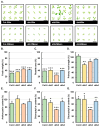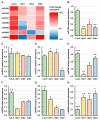DRB1, DRB2 and DRB4 Are Required for an Appropriate miRNA-Mediated Molecular Response to Osmotic Stress in Arabidopsis thaliana
- PMID: 39684274
- PMCID: PMC11641234
- DOI: 10.3390/ijms252312562
DRB1, DRB2 and DRB4 Are Required for an Appropriate miRNA-Mediated Molecular Response to Osmotic Stress in Arabidopsis thaliana
Abstract
Arabidopsis thaliana (Arabidopsis) double-stranded RNA binding (DRB) proteins DRB1, DRB2 and DRB4 perform essential roles in microRNA (miRNA) production, with many of the produced miRNAs mediating aspects of the molecular response of Arabidopsis to abiotic stress. Exposure of the drb1, drb2 and drb4 mutants to mannitol stress showed drb2 to be the most sensitive to this form of osmotic stress. Profiling of the miRNA landscapes of mannitol-stressed drb1, drb2 and drb4 seedlings via small RNA sequencing, and comparison of these to the profile of mannitol-stressed wild-type Arabidopsis plants, revealed that the ability of the drb1 and drb2 mutants to mount an appropriate miRNA-mediated molecular response to mannitol stress was defective. RT-qPCR was next used to further characterize seven miRNA/target gene expression modules, with this analysis identifying DRB1 as the primary DRB protein required for miR160, miR164, miR167 and miR396 production. In addition, via its antagonism of DRB1 function, DRB2 was shown by RT-qPCR to play a secondary role in regulating the production of these four miRNAs. This analysis further showed that DRB1, DRB2 and DRB4 are all required to regulate the production of miR399 and miR408, and that DRB4 is the primary DRB protein required to produce the non-conserved miRNA, miR858. Finally, RT-qPCR was used to reveal that each of the seven characterized miRNA/target gene expression modules responded differently to mannitol-induced osmotic stress in each of the four assessed Arabidopsis lines. In summary, this research has identified mannitol-stress-responsive miRNA/target gene expression modules that can be molecularly manipulated in the future to generate novel Arabidopsis lines with increased tolerance to this form of osmotic stress.
Keywords: Arabidopsis thaliana (Arabidopsis); DRB1; DRB2; DRB4; double-stranded RNA binding (DRB) protein; mannitol; miRNA-directed gene expression regulation; microRNA (miRNA); osmotic stress.
Conflict of interest statement
The authors declare no conflicts of interest.
Figures





Similar articles
-
The Arabidopsis thaliana Double-Stranded RNA Binding Proteins DRB1 and DRB2 Are Required for miR160-Mediated Responses to Exogenous Auxin.Genes (Basel). 2024 Dec 21;15(12):1648. doi: 10.3390/genes15121648. Genes (Basel). 2024. PMID: 39766914 Free PMC article.
-
DRB1, DRB2 and DRB4 Are Required for Appropriate Regulation of the microRNA399/PHOSPHATE2 Expression Module in Arabidopsis thaliana.Plants (Basel). 2019 May 13;8(5):124. doi: 10.3390/plants8050124. Plants (Basel). 2019. PMID: 31086001 Free PMC article.
-
DRB2 is required for microRNA biogenesis in Arabidopsis thaliana.PLoS One. 2012;7(4):e35933. doi: 10.1371/journal.pone.0035933. Epub 2012 Apr 24. PLoS One. 2012. PMID: 22545148 Free PMC article.
-
DRB1 and DRB2 Are Required for an Appropriate miRNA-Mediated Molecular Response to Salt Stress in Arabidopsis thaliana.Plants (Basel). 2025 Mar 15;14(6):924. doi: 10.3390/plants14060924. Plants (Basel). 2025. PMID: 40265861 Free PMC article.
-
MicroRNA-Mediated Responses to Cadmium Stress in Arabidopsis thaliana.Plants (Basel). 2021 Jan 10;10(1):130. doi: 10.3390/plants10010130. Plants (Basel). 2021. PMID: 33435199 Free PMC article.
Cited by
-
Transcriptomic Characterization of miRNAs in Apis cerana Larvae Responding to Ascosphaera apis Infection.Genes (Basel). 2025 Jan 26;16(2):156. doi: 10.3390/genes16020156. Genes (Basel). 2025. PMID: 40004485 Free PMC article.
References
-
- Kinoshita N., Wang H., Kasahara H., Liu J., Macpherson C., Machida Y., Kamiya Y., Hannah M.A., Chua N.H. IAA-Ala Resistant3, an evolutionarily conserved target of miR167, mediates Arabidopsis root architecture changes during high osmotic stress. Plant Cell. 2012;24:3590–3602. doi: 10.1105/tpc.112.097006. - DOI - PMC - PubMed
MeSH terms
Substances
LinkOut - more resources
Full Text Sources

